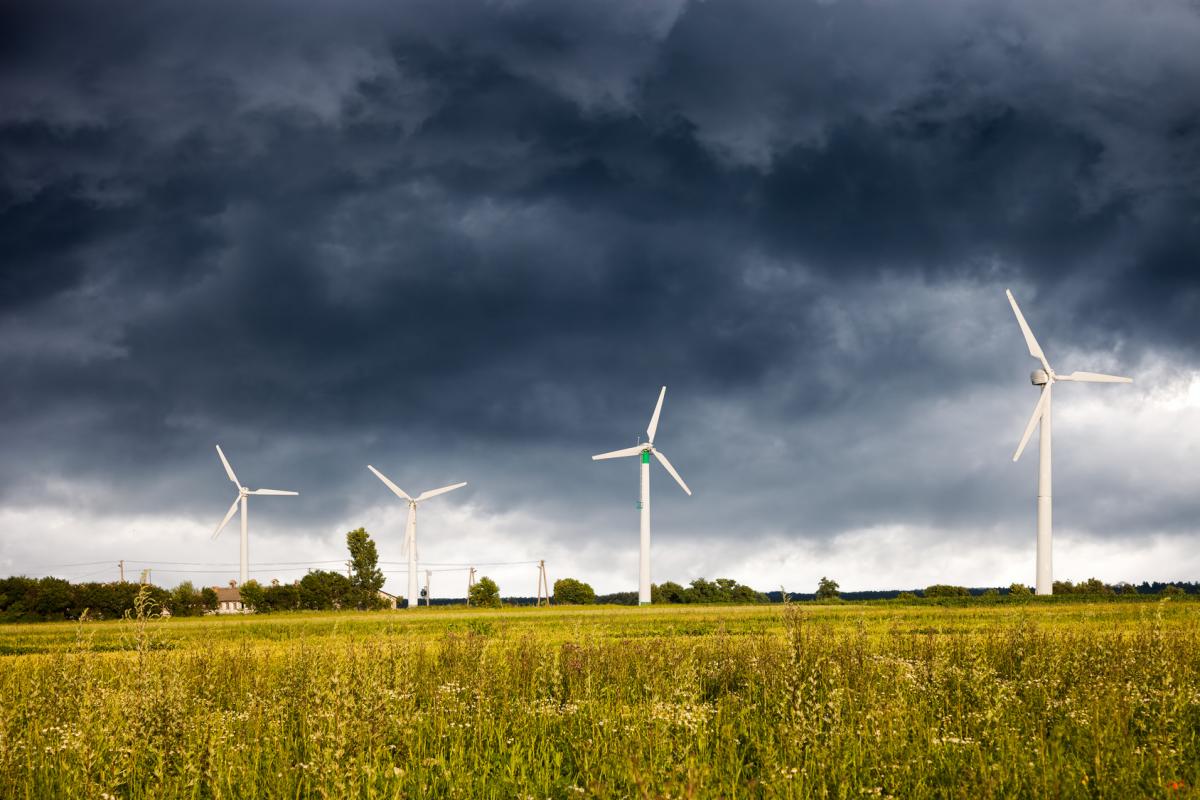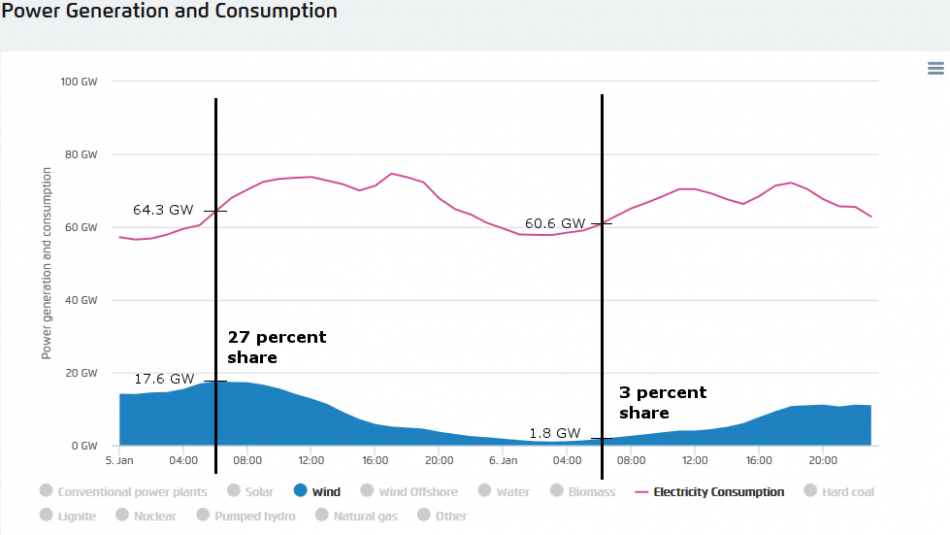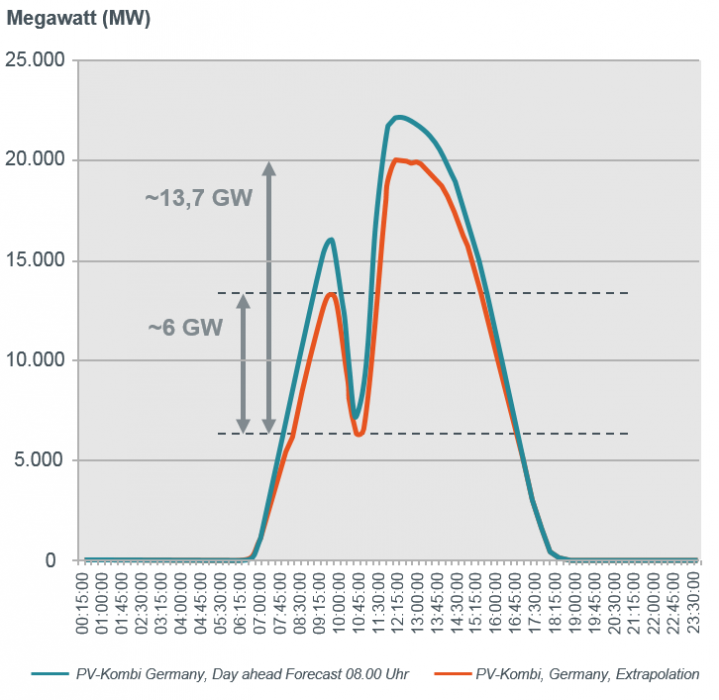Weather forecasts aim to make renewable power predictable
If Germany stays true to its targets for decarbonising the power sector, a minimum of 80 percent of the country’s gross power consumption will come from renewable sources by 2050. Most of this will come from wind and solar power, two volatile sources.
Critics of such a fast increase of the renewables share say that over the coming decades the continued support of fossil fuel power plants is still needed. As long as storage solutions are insufficient, volatile power forms such as wind and solar could not guarantee a secure electricity supply, they argue.
Michael Vassiliadis, head of the Trade Union for Mining, Chemicals and Energy Industries (IG BCE), recently told industry magazine vdi nachrichten: “After switching off the last nuclear power plants in 2022, Germany will face a supply gap – unless we continue to use lignite as a bridge technology for some time.”
Electricity generation charts provided by think tank Agora Energiewende* show that – already today – the share of wind power in German total electricity consumption can vary by more than 24 percentage points during the course of 24 hours – a difference that operators need to balance out to keep the grid stable.
Yet, bigger challenges await. Grid operators will face even larger and more sudden drops and increases of electricity feed-in due to the continued expansion of wind and solar power. A rare and spectacular natural event last year provided a training lesson: German grid operators had to balance out a 2.67 gigawatt decrease and a 4.11 gigawatt increase of solar PV power within 15 minutes when the moon cast its shadow on the Earth during the partial solar eclipse on 20 March 2015. In this case, the operators had plenty of time to prepare for the event and managed to keep the grid stable. Weather forecasts were key to predicting the fluctuation of solar power production.
“This feed-in increase was four times as strong as what we regularly have to deal with. But with the share of renewables rising, this will become the daily norm by 2025-2030,” says Gunter Scheibner, head of system operations at 50Hertz.
How weather forecasts can ease the challenge of volatility
“Weather forecasts provide indispensable information for a safe and efficient management of the power grid,” says Renate Hagedorn, a scientist at the national German weather service Deutscher Wetterdienst (DWD). Improvements of forecasts over the past 15 years have made the feed-in of renewable electricity into the grid much more predictable.
“For our control area in north-eastern Germany, we currently have an average deviation [RMS error] of 2-4 percent for wind power and 5-7 percent for PV for the day-ahead forecasts,” says 50Hertz’s Scheibner of the company’s electricity feed-in predictions.
That is thanks to power generation forecast service providers like energy & meteo systems. Together with the DWD, grid operators and research institutes like Fraunhofer IWES, they have changed the composition of weather predictions to adapt the system to the new needs, and included additional information about the renewables facilities in their calculations.
“They have never looked there. They only looked at altitudes around 10m, but not 100m,” Ulrich Focken, managing director of energy & meteo systems, says about traditional forecasts by weather services. “We don’t care at all about what happens at 10m.”
The DWD confirms: “We adapt to the particular needs of our energy sector customers, for example by optimising the wind forecasts at the hub height of wind turbines […] or expanding our forecasts to offshore areas,” says Renate Hagedorn.
The need for data
Exact weather forecasts, however, are not the only ingredient needed to predict the electricity feed-in of Germany’s renewables fleet. Live feed-in data, metadata from the facilities such as the generation capacity or the exact location of a wind turbine, and historical feed-in data help to optimise the prediction models developed by service providers like Focken and his team.
But while almost all wind turbines and most large solar PV parks are capable of sending live data on how many megawatts of electricity they are currently feeding into the grid, getting hold of this information can be tricky for technical or data privacy reasons.
In this respect, German power supplier Next Kraftwerke is in a uniquely advantageous position. The company operates a large-scale virtual power plant that integrates a vast number of renewables facilities – wind power, solar PV, biogas – into one virtual complex. Next Kraftwerke has live data for every facility connected to its power plant. “That means, we can predict the power feed-in much better than other electricity marketers,” says spokesperson Jan Aengenvoort.
Germany as a frontrunner
Progress in the area of power generation prediction tools was especially intense in Germany, with the Energiewende and the strong regulatory activity surrounding the country’s development of renewable energies.
“Otherwise, we wouldn’t have made this progress,” says Focken of energy & meteo systems. The company was founded in 2004, dominated the German wind power forecast market in 2005, and from 2009 has been one of the world’s leading companies providing wind power forecast, according to Focken. “Globally, there are not 10 companies comparable to us.” Similar to his company, many German power generation forecast service providers offer their products all over the world.
But it is not a big-money business. “It’s a niche market,” says Focken. His company today has about 70 employees. Many other forecast businesses operate with 10 employees or less.
Demand-side forecasts offer more room for improvement
Scheibner, of 50Hertz, said: “Because of more and more decentralised power supply, the blurriness of the feed-in situation will grow in the future.” The need to improve power generation forecasts will, therefore, remain. With current weather forecasts, calculation models, and the percentage of facilities that supply live feed-in data, these supply-side forecasts are already very accurate. So, at a certain point, the cost to bring about a significant improvement exceeds by far its effect, says Scheibner.
He sees room for improvement mostly on the demand side. The introduction of smart meters for consumers with the law on the digitalisation of the Energiewende passed by the German parliament in July 2016 is a first step. “There, we are hoping that through additional live data we’ll have the possibility to converge the prediction systems with the reality,” says Scheibner. Predicting – and, in the end, managing – demand as well as supply will be key to creating a system balanced to near perfection.
The role of renewable power in the system security profits from exact forecasts. But factors such as energy storage and the manageability of virtual power plants like that of Next Kraftwerke will also be important.
Phasing out fossil fuels for electricity generation in the mid-term future seems possible. Boris Schucht, CEO of 50Hertz, recently said in an interview that he was confident that the company would be able to integrate a share of 70 to 80 percent renewables, even “without additional flexibility options”.
And in February 2016, the grid operator for the first time succeeded in classifying wind power as control power to potentially stabilise the grid and play its part in the security of the system. This was made possible, to a large extent, by exact forecasts.
*Like the Clean Energy Wire, both Agora Energiewende and Agora Verkehrswende are projects funded by Stiftung Mercator and the European Climate Foundation.




